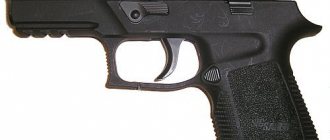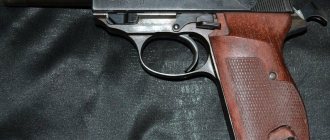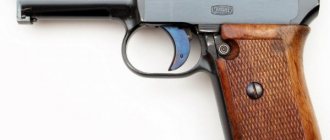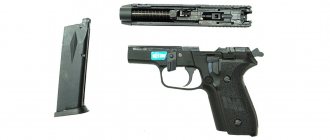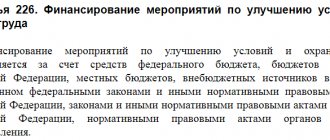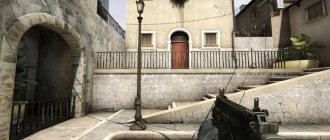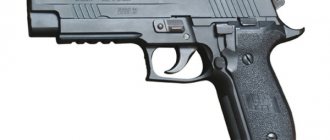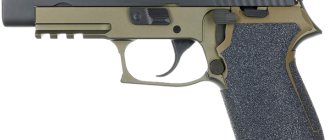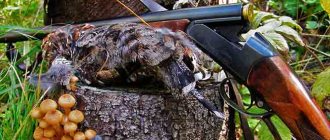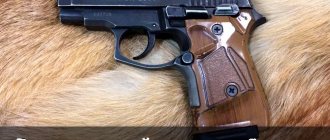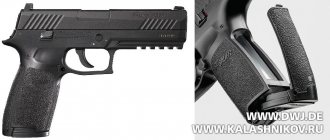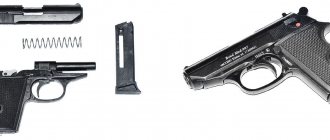Pistol Sauer 38H (Germany)
Sauer 38H pistol, left view. The safety levers (on the bolt) and the cocking/safe release levers (on the frame, behind the trigger) are clearly visible.
Sauer 38H pistol, right view.
Pistol Sauer 38H, late war release. To save money, the cocking/safe release lever has been removed from the design.
Sauer 38H pistol, released at the very end of the war. The pistol has no coating on the external surfaces, and for reasons of economy, both the safety and the cocking/safety release lever are excluded from the design.
Characteristic
| USM | double acting |
| Caliber | 7.65x17mmSR Browning (7.65mm Browning) |
| Weight without cartridges | 705 g |
| Length | 171 mm |
| Barrel length | 83 mm |
| Magazine capacity | 8 rounds |
The development of a new pocket pistol with a self-cocking trigger mechanism and suitable for civilian and police use was started by the old German arms company JP Sauer & Son back in 1933. However, development for various reasons dragged on for 5 years, and the final version of the pistol appeared only in 1938, under the designation Sauer 38H (the letter H stands for “ hahn
“, that is, the trigger - all previous Sauer pistols had striker-fired triggers). The pistol turned out to be extremely successful, easy to use and quite reliable. During the Second World War, several tens of thousands of such pistols were purchased for the Armed Forces of Hitler's Germany. At the very end of the war, due to the growing needs for weapons of the retreating Wehrmacht, the Sauer company gradually began to simplify the design and external decoration of its pistols, abandoning “redundant” controls. After the war, production of the Sauer 38H pistols was not resumed, but the influence of the design of its trigger mechanism and safety is clearly visible in a number of post-war pistols, especially in models such as the HK P9S and, to a lesser extent, the SIG-Sauer P220.
The Sauer 38H pistol uses a blowback automatic pistol with a fixed barrel. The return spring is placed around the barrel. To disassemble the weapon, there is a special lock located inside the trigger guard and pulled down. The design feature of the pistol is that there is a separate bolt insert inside the bolt casing. which contains the extractor, firing pin and indicator of the presence of a cartridge in the chamber. The insert is fixed in the bolt with a transverse pin. The indicator of the presence of a cartridge in the chamber has the form of a pin that extends backwards from the rear end of the bolt if the cartridge is in the barrel. The trigger mechanism is hammer-operated, double-action (self-cocking), with a hidden trigger. Cocking and releasing the hammer can be done either by pressing the trigger or by pressing a special lever located under the left cheek of the handle. Additionally, there is a manual safety on the bolt that locks the trigger when engaged. Single-row magazines with a capacity of 8 rounds. The magazine latch looks like a button and is located at the base of the trigger guard on the left.
Competitor for "Walter"
The Sauer 38 was conceived as a competitor to the Walther PP and PPK pistols. It was mass produced during World War II and supplied to the police and the Wehrmacht. After the war, the pistol did not have much importance, except for its use in the People's Police of the GDR.
In 1929, with the adoption of the Walther PR model, a revolution in weapons technology occurred. With the advent of this pocket-carry pistol with its reliable, self-cocking trigger mechanism that ensures it is ready to fire quickly, all competitors in this market segment have lost their former importance. Both civilians and employees wanted to have a police pistol (Polizeipistole) from Carl Walther or its smaller version, the PPK model.
This hit the Suhlian arms manufacturer Sauer & Sohn especially hard. This company introduced the Model 1930 pistol to the market in the fall of 1930, as well as a service model. Both pistols were improved versions of the 1913 model. Although the 7.65 mm Browning caliber service model had a special trigger safety, it, like the 1930 model, was a weapon with a single-action trigger, without self-cocking. Both pistols were rejected by the German police due to their outdated design. A new pistol has appeared
However, already in 1932, the management of the Sauer & Sohn company decided to develop a completely new pistol. It should have at least come close to the Walther PP or PPK pistols, but without infringing patent rights. This development was entrusted to the chief designer Fritz Zehner, together with his son Hans, the head of the experimental workshop. The protocol dated March 1934 contained some requirements for a new 7.65 mm Browning pistol. It must be closed on all sides in order to protect the mechanism from dust and foreign bodies. It should be a pistol for pocket carry with an internal trigger, in which even the groove for the trigger should be made as compact as possible.
In the first and last versions of the Sauer & Sohn 38 model, the manufacturer abandoned the safety lever on the bolt.
In addition, a practical double-action trigger mechanism with self-cocking was required, and the hammer with an internal location should be cocked without problems and safely. In this case, the user could shoot in pre-cocking mode, with a reduced trigger pull. For this purpose, a cocking lever located on the left, which barely protruded from the weapon, served. With its help, the shooter could cock the hammer without changing the position of his hand when shooting. And, conversely, with the help of this lever it was possible to bring the weapon into an uncocked state without any problems. If, after moving the bolt during reloading or after firing, the internal hammer remained cocked, then using the same technique as during cocking, it could be decocked. Due to the presence in the new weapon of a lever for cocking the hammer and for decocking it, they deliberately abandoned the safety lever or the lever for safely decocking the hammer as in the Walther PP and PPK models.
On the right side, the Sauer & Sohn 38 also looks quite comfortable to hold and definitely has sweeping contour lines.
On May 18, 1934, Sauer & Sohn provided a pistol for testing at the Prussian testing station in Suhl. This gave positive results. The functioning of the cocking lever, which also ensures the decocking of the hammer, the signal pin as an indicator of the presence of a cartridge in the chamber, as well as the magazine safety, which acts on the trigger mechanism and prevents the shot from being fired after the magazine has been separated, were noted.
In April 1935, the following conclusion was added from the German Small Arms Test Station (Deutsche Versuchsanstalt fuer Handfeuerwaffen), abbreviated DEVA. It had a positive assessment of the cocking lever, which made manual cocking of the externally located trigger unnecessary, as with PP/PPK pistols. DEVA also noted the elimination of a manual safety lever as an advantage.
Along the Walther route
In 1933, Dr. Robert Ley, an influential Reichsleiter and head of the organizational department of the NSDAP party, visited the Walther factories in Zella-Mehlis. Soon, impressed by modern products, he entered into the official NSDAP directory on the structure of the NSDAP and party organizations (Organisationsbuch der NSDAP) the following entry: “Political leaders wear award weapons, pistols (Kal.7.65 mm Walther PPK) granted by the Fuhrer... The right to wear award the political leaders of the state territory have weapons: Reichsleiter, Gauleiter and Kreisleiter, as well as leaders of local organizations and strongholds. In addition, upon the recommendation of an authorized representative of the authorities, the right to carry pistols can be granted by Gauleiters of political leaders of local organizations or strongholds.”
A technical feature of this pocket pistol is the lever behind the trigger that cocks and releases the hammer. In both actions the lever is pressed down.
The commercial business of the Walther company flourished, since in 1933, with a party membership of 3.9 million, the need for pistols for large and small “golden pheasants” was great (as swaggering Nazi officials were then ironically called in Germany. - Translator’s note). Later, Walther PP or PPK pistols were equipped with “assault squads” (Sturmabteilung = SA = SA), as well as “security squads” (Schutzstaffel = SS = SS) of the NSDAP.
Thus, Walther gained a monopoly position. And the company was fully loaded with work, while for the Sauer & Sohn company during this period of time, a reduced work schedule of two days a week was common in the pistol division. To complicate matters further, the gun manufacturer found itself with 5,000 handguns in storage that were suddenly obsolete.
Commercial Director
Ralf Sauer wrote to the NSDAP. Shortly thereafter, Walther generously offered to Sauer & Sohn that it could produce valves for the PPK model, mostly in the “white” state of completion, without coating, with the appropriate dimensions and tolerances. However, Sauer & Sohn did not want to become a contractor for Walther and refused. Moreover, the company wanted to spend time and money on its own new pistol design.
The Sauer & Sohn pocket pistol has a hidden trigger inside. This property also contributes to the compactness of the weapon.
On November 30, 1934, Sauer & Sohn sent a prototype pistol to a departmental institution to prepare the leadership of the NSDAP in Munich. In addition, the Suhlian company secured itself by the fact that this model could be additionally equipped with a separate safety switch, despite the fact that this, strictly speaking, was not necessary. Turnaround in favor of Sauer & Sohn
At the end of 1935, the NSDAP leadership gave preference to the Walther PРK pistol as a reward weapon for political leaders. However, samples of weapons from other manufacturers could also be selected.
For officers of the German Wehrmacht, pocket pistols, most often in 7.65 mm Browning caliber, were common as self-paid service weapons.
In addition, in 1935, the shooting championship of assault troops took place in Zella-Melis. Naturally, in the “Pistol” discipline, only the PPK and PP models from Walther were used. Along with the SA fighters, many uniformed and civilian guests were also present, as well as volunteers, among them Erich Krempel. By chance, he was Hans Zähner's right-hand man and the future winner of the silver medal in the free pistol event at the 1936 Summer Olympics in Berlin. Krempel unpacked the Model 36 pistol (even during 1935, Sauer & Sohn had already used the designation Modell 36 for its newly designed pistol), demonstrated its capabilities at the shooting range, and thereby attracted the attention of numerous spectators. Among them was also a high SA leader from Munich, who eventually opened the way for the Sauer pistol to the top leadership of the SA.
This was in 1937. The strongest argument in favor of the Sauer pistol was the internal trigger. When planning a large order, we were talking about 50 thousand copies. In April 1937, in Munich, two SA Fuhrers received a prototype. On May 27, 1937, Rolf Sauer and Hans Zehner demonstrated the weapons to these two leaders. SA Chief of Staff Viktor Lutze also received one copy. Outwardly he looked pleased.
From the Sauer 36 came the Modell 38
Then, for the first time, there was talk about the Modell 38 pistol, although its design was still consistent with the original Model 36. Sauer & Sohn believed that due to difficulties with the supply of steel, production of the new design could begin only in 1938.
Basically, personal officer weapons were distributed through arsenals or private companies and were entered into the military record book as an authorized service pistol.
In mid-1937, the master of the experimental workshop, Erich Krempel, demanded a slight extension of the handle. This should have improved the position of the weapon in the hand. The handle has been lengthened by 8 mm. The magazine of the new model held eight rounds of 7.65 mm Browning caliber instead of seven in the previous one.
The old seven-round model and the new eight-round prototype were presented to the SA leadership in the second half of 1937. The choice fell on the extended model. On August 2, 1937, the Berlin leadership of the SA received two prototypes - one of 7.65 mm Browning caliber, the second of .22 lr caliber. Both types of weapons were supposed to publicly “perform” on August 13 of the same year during the all-German SA championship at the DEVA stand in the Berlin area Wannsee. In the “Pistol Shooting” section of the competition, almost all shooters shot from the previously standard SA weapons - Walther PP and PPK pistols. Only one senior SA leader used both prototypes. Of course, both types of weapons encountered delays. Therefore, the Brigadeführer then began to shoot from a Walther PR pistol.
Officer pistols were subjected to firing tests according to civilian rules. The mark “eagle with S” meant that the weapon was accepted for the German police.
From this, the SA leadership concluded that the new Sauer pistol, in general, is suitable as a service weapon, but this depends on the conclusion of the Army Weapons Directorate. An order for a weapons manufacturer from Suhl also depended on him. Therefore, Sauer & Sohn sent a copy for testing to the army testing station in Kummersdorf. The conclusion turned out to be favorable. As a result, from September 1, 1937, the S&S M38 pistol was accepted as the official service weapon of the SA. Delivery of the M38 pistol was expected from April 1938. Proposals to the Wehrmacht and police
The new Sauer pistol was already known to the Wehrmacht before. Back on January 28, 1937, three models were sent to the Army Weapons Directorate for testing, calibers 7.65 mm Browning, 9 mm kurz and .22 lr. But already on March 5, 1937, these weapons were sent back. The reason for this was quite definite: the safety of the shooter was not ensured, since the trigger could be pulled out of the cocking position before the weapon bore was locked. In addition, in order to disassemble the weapon, it was necessary to insert a magazine, and the absence of a bolt stop complicated cleaning. Added to this was the requirement for a separate additional safety, since cocking and decocking the hammer using a single lever and acting on it from the same starting position could lead to accidents.
The instruction manual extensively praised the accuracy of shooting, the principle of the device, ease of use, safety and constant readiness to fire.
Already on March 11, 1937, a response was received from Sauer & Sohn - two experimental pistols with additional fuses designed in different ways. However, the quick reaction did not lead to a change in the opinion of the Army Weapons Directorate.
The company offered the pistol to police and other armed employees. Finally, on April 1, 1938, the new pistol was adopted by the police, but this nevertheless did not lead to a large order.
Breakthrough
A press advertisement from January 1939 showed a new Sauer pistol with an additional mechanical safety. The safety lever blocked the trigger. In the aforementioned message, the pistol was designated Modell 38. However, in internal official correspondence and later in the Sauer & Sohn operating instructions, as well as on the presentation box, the weapon was designated Modell H. Probably the letter H meant the planned consumer - Heer (army), who from the very beginning wanted to have an additional fuse. After some time, another new meaning for the letter H took root, namely mit Hahnsicherung (with trigger safety).
Sauer & Sohn M38 pistol, disassembled for cleaning. The locking engine, which absorbs the shock of the bolt during recoil, is moved down inside the trigger guard until it stops. The barrel is firmly and motionlessly connected to the frame, which contributes to increased accuracy of the weapon. The return spring is compactly placed on the barrel, covering it.
The Sauer & Sohn company announced deliveries of the pistol to wholesalers at the beginning of 1939. Of course, most of them remained unfulfilled, because significant production of the new pistol began only in 1940. Then the main customers were the police and, above all, the army.
Weapons for the Wehrmacht were shot according to the rules for civilian weapons and were accepted by the Armament Directorate of the Ground Forces with the stamp “eagle with 37”. In the German armed forces, the pistol was also in demand as a personal weapon for officers. The Sauer model was supplied through the arsenals of the Wehrmacht Military-Technical Property Directorate, independently purchased by officers and entered into the military record book as an authorized service weapon.
In the photo on the left there is an indication on the bolt indicating the caliber 7.65 mm Browning. In the photo on the right is the mark of the Army Weapons Directorate: “eagle” and the number 37.
From 1940 to 1944, the company constantly increased production volumes of Sauer pistols. They decreased only in 1945, the last year of the war. In 1944, Sauer & Sohn received a large order from the Army Weapons Directorate for more than 60 thousand pieces. Both sides have made efforts to simplify production since 1943. Thus, they saved money on finishing the external surface, the company’s usual address disappeared - only the “Cal” brand remained. 7.65", stamped on the bolt. The trigger and magazine cover were not made of steel or sheet steel - both parts were made of zinc alloy by injection molding. In addition, the Army Weapons Department demanded the abolition of the additional fuse.
Production officially ended on April 3, 1945, with the arrival of American troops. Of course, the Americans could make several more Sauer M 38 pistols, assembling them from spare parts. Disassembly and assembly
Disassembly for cleaning can be done with the safety switch on and off. After a mandatory check for unloading with the magazine compartment, the locking slide, which absorbs the shock of the bolt during rollback, moves down inside the trigger guard until it stops. Then the bolt is pulled back all the way and raised up. After this, controlling the pressure of the bolt spring, you can move it forward along the frame. Finally, you can remove the recoil spring from the barrel.
Assembling the weapon is carried out in the reverse order. DWJ findings
Both weapons, which were produced and used during World War II, impressed members of the German editorial staff of DWJ as modern. First of all, the lever that cocked and decocked the hammer was considered innovative. Gerhard Ortmeier Translation by Nikolai Yezhov
Design details[edit]
The "H" in the model number indicates that this pistol uses a closed hammer, as opposed to the striker-fired action of earlier Sauer models. Other features included a traditional double-action trigger, a single-column magazine, and an action spring surrounding a fixed barrel.
A revolutionary feature was the use of a lever that was either cocked or triggered (reset). This is the first pistol equipped with a device of this type [6] (located on the left under the bolt, just in front of the handle). The Sauer 38H hammer could be lowered for safe carrying at any time. The cocking function was necessary due to the closed hammer, and the release mechanism was necessary for safety. A cavity on the trigger indicated whether the hidden hammer was cocked; if completely exposed, the hammer was lowered. A small pin protruded from the rear of the shutter as a charged camera indicator.
Another advanced feature for the time was the magazine safety, a device that disables the trigger when the magazine is removed from the pistol. Virtually all modern pistols produced by SIG Sauer today are trigger-fed, including the highly successful SIG Sauer P226 family. Most modern SIG Sauer pistols have controls in much the same location as the Sauer 38H, although since these modern designs have exposed hammers, there is no cocking function on the lever. The Heckler & Koch P9 also uses a cocking/decocking lever based on the Sauer 38H. [7]
The pistol grips were made of bakelite. Age often causes the grips of surviving specimens to crack and crumble. All original grips bore the inscription "SUS", meaning "Sauer und Sohn", which could be found on the same side of the pistol as the magazine release, although many reproduction grips copied this logo. It is unusual for a modern example to have the original handles intact.
The Sauer 38H was produced primarily in .32 ACP, although some rare examples were also chambered in .380 ACP and .22 LR. The Model 38H was used by German military forces such as the Luftwaffe, as well as police forces in numbers almost equal to the Walther PPK. The Sauer 38H was produced for the military, police and commercial markets.
Links[edit]
- Small Arms Review (2005). "Sourcing the Weapons of War: Small Arms Supply to Conflict Zones" (PDF). Small Arms Review 2005: Guns at War. Oxford University Press. item 166. ISBN. 978-0-19-928085-8.
- Chamberlain, Peter (1976). Axis pistols, rifles and grenades
. Gander, Terry. New York: Arco. paragraph 20. ISBN 0668040769. OCLC 2388349. - Smith, W. H. B. (1968). Book of Pistols and Revolvers
(7th ed.). Harrisburg, PA: Stackpole. pp. 283–288. - https://luger.gunboards.com/showthread.php?2722-Selected-results-from-RIA&s=e3a71491f6f694eae491bee183fbd3e5
- https://www.tague.at/pistolen/pages/en_sauer38h.htm
- Firearms Treasury News, 17th Annual, p. 28
- Sauer 38H
Development[edit]
Sauer developed the Model 38H from its earlier semi-automatic pistols. It was necessary to compete in the commercial market with companies such as Mauser and Walther. [3] However, with the outbreak of war, most of the pistols were sent to various German police services. These pistols were stamped by these agencies and some can still be found with the holster and extra magazine they were distributed with. The Sauer 38H pistols presented to Nazi officials often had custom engravings, ivory grips, and often gold inlay. For example, in September 2004, Rock Island Auction Company sold a Sauer 38H serial number 363573 owned by Sepp Dietrich for $43,125. [4]
The Sauer 38H was produced in three main models. As a rule, on the slide of the first model on the left it is written “JP Sauer und Sohn”. The second version only says "CAL 7.65" and the third version omits the safety and cocking/releasing lever. Towards the end of the war, the weapons produced were simplified for faster and cheaper production. For the 38H, this meant simpler markings, a rougher finish, and the elimination of features such as the slide guard. Much less commonly, some late production examples retained safety but did not have a cocking/decocking lever. The so-called "late war" models remained fully functional, although the last examples produced before April 1945, when the factory was captured by the Allies, had inconsistent serial numbers and poor fit and finish.
The Sauer 38H concept continues in the SIG Sauer P232 and its predecessor, the P230, which also have a fixed barrel, decocking lever, and similar internal design. As a testament to their fine design, many Sauer 38Hs are regularly used by owners to this day, although usually with interchangeable grips.
